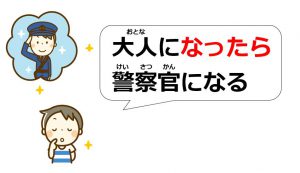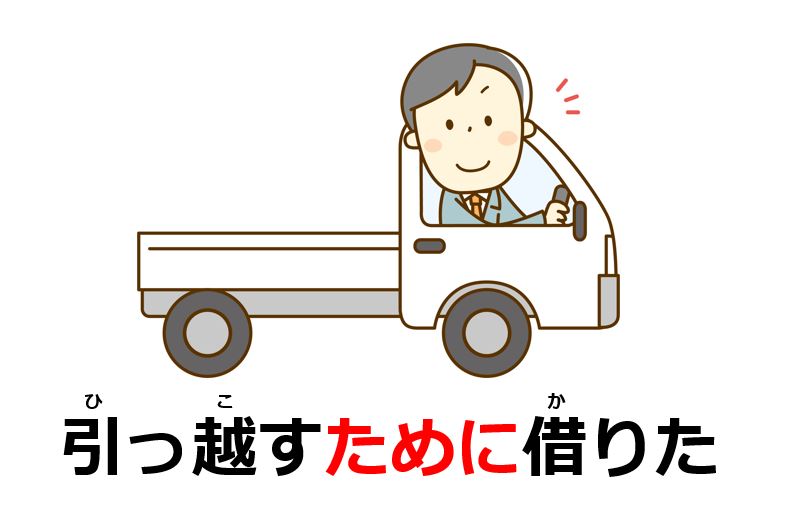Last time, you learned how to express reasons, e.g. “弟が住んでいたから、オーストラリアを旅行しました (I traveled to Australia because my younger brother lived there).” Then, if you would like to say “I traveled to Australia to meet my younger brother,” what should you say? The meanings are similar, but the sentence patterns that you use should be different. In this lesson, you will learn how to express aims.
Explanation for Usages of …ために, …に, …のに, and …ように
| Table of Contents …ために: Aims, Benefits, and Causation …に: Aims of Motion …のに: Aims of Use …ように: Ideal Situations |
In English, you express aims by using expressions such as “to do” and “for doing.” In Japanese grammar, aims can be further divided, and you need to use different sentence patterns depending on the usage. Let’s check them one by one.
…ために: Aims, Benefits, and Causation
| [私は] | 海外旅行をするために | 貯金(した / しました) |
| [Topic / Subject] | Aim | Verb |
| [I] saved money to travel abroad. | ||
ために is one of the most basic sentence patterns to express aims like “to do,” and “in order to do.” The conjugation is to attach the plain (dictionary) form to ために. Subjects should be the same in the aim part and the verb part, that is to say, the same person saved money and will travel abroad in the above example. There is another important point; volitional verbs should be used.
| ケンに会うために日本へ(来た / 来ました)。 [I] came to Japan to meet Ken. |
| 医者になるために勉強して(いる / います)。 [I] am studying to be a doctor. |
| ちゃんと理解するために議論したい(です)。 [I] want to discuss [it] to understand properly. |
We sometimes drop に, but the meaning will remain the same.
| ケンに会うため、日本へ(来た / 来ました)。 |
| 医者になるため、勉強して(いる / います)。 |
| ちゃんと理解するため、議論したい(です)。 |
If you use ために with nouns, you can express benefits like “for” and “for the sake of.” With this function, you need to attach の to nouns.
| 準備のために辞書を(買った / 買いました)。 [I] bought a dictionary for preparations. |
| 子供のために働いて(いる / います)。 [I] am working for [my] child. |
| 安全のため、ルールを(守ろう / 守りましょう)。 Let’s keep the rule for the sake of safety. |
ために is an expression for aims, but you can express causation in the following two situations: (1) if subjects in the aim and the verb part are different and (2) If non-volitional verbs, nouns or adjectives are used in the aim part. There are two points where you need to take care. Firstly, it sounds more natural when you drop に. Secondly, you cannot use ために when you make requests, invitations, commands, and such expressions
| 台風が来たため、お店が休み(だ / です)。 The shop is close because the typhoon came. |
| 体調が悪いため、会社に行け(ない / ません)。 [I] cannot go to office because [I’m] under the weather. |
In this context, ため(に) is interchangeable with から and ので.
| 台風が来た から・ので、お店が休み(だ / です)。 |
| 体調が悪い から・ので、会社に行け(ない / ません)。 |
[adsense]
…に: Aims of Motion
| [私は] | ランチを食べに | 行く / 行きます |
| [Topic / Subject] | Aim of Motion | Verb |
| [I] will go to lunch. | ||
The function is to express aims of motion and thus you use …に with verbs which indicate motion such as 行く, 来る, and 帰る. The conjugation is to utilize the polite form and attach に instead of ます. If objects in the aim part imply actions, you can directly attach に to it without verbs, i.e. ランチ implies “to eat” so you can say both “ランチを食べに行く” and “ランチに行く.”
| 買い物をしに(来た / 来ました)。 [I] came [here] to do shopping. |
| 家へ休みに(帰った / 帰りました)。 [I] went home to take a rest. |
| お父さんは仕事に(行った / 行きました)。 [My] father went to work. |
…ために can express almost the same thing, though …に sounds more natural.
| 買い物をするために(来た / 来ました)。 |
| 家へ休むために(帰った / 帰りました)。 |
| お父さんは仕事をするために(行った / 行きました)。 |
…のに: Aims of Use
| スマートフォンは | 音楽を聞くのに | 便利(だ / です) |
| Topic / Subject | Aim of Use | Predicate |
| Smartphones are useful to listen to music. | ||
The function is to express aims of use and thus you often use …のに with predicates which indicate use like “使う: to use,” and “役に立つ: helpful,” “必要: necessary,” and “便利: useful.” The conjugation is just to attach the plain (dictionary) form to のに. Likewise …に, if objects in the aim part imply actions, you can express the same thing by means of attaching に without verbs (*Look at the first example below).
| 車は通勤に使って(いる / います)。 As for the car, [I] use [it] for the commute. |
| パソコンは仕事をするのに必要(だ / です)。 (A) PC is necessary for working. |
| 鍋はお茶を作るのに役に(立つ / 立ちます)。 Pots are helpful for making tea. |
You can replace のに with ために, too.
| 車は通勤のために使って(いる / います)。 |
| パソコンは仕事をするために必要(だ / です)。 |
| 鍋はお茶を作るために役に(立つ / 立ちます)。 |
…ように: Ideal Situations
| [私は] | 試験に落ちないように | 勉強(した / しました) |
| [Topic / Subject] | Ideal Situation | Verb |
| [I] studied so as not to fail the exam. | ||
ように expresses aims by describing ideal situations. The conjugation is to attach the plain (dictionary) form to ように. If the ように part is affirmative, non-volitional verbs should be used. If the ように part is negative, both volitional and non-volitional verbs can be used.
| 雨が降るように(祈った / 祈りました)。 [I] prayed so that it rains. |
| 日本語が話せるようになりたい(です)。 [I] want to become able to speak Japanese. |
| 健康になるように牛乳を飲んで(いる / います)。 [I’m] drinking milk so as to be healthy. |
Note: you CANNOT replace ように (ideal situations) with ために (aims). They are different. Only ように allows you to do two things; you use non-volitional verbs, which includes the potential form, and you set different subjects in the ように part and the verb part. For reference, only ために allows you to use volitional verbs when the aim part is affirmative.
| 雨が降るように(祈った / 祈りました)。 => Correct |
| 雨が降るために(祈った / 祈りました)。 => Wrong |
| ケンに会うように日本へ(来た / 来ました)。 => Wrong |
| ケンに会うために日本へ(来た / 来ました)。 => Correct |
Let us clarify the usage to make sure. Even though you use volitional verbs in the affirmative aim part, you can still use ように if the subject in the aim part is different from the one in the verb part.
| 子供がたくさん勉強するように、いい机を(買った / 買いました)。 [I] bought a good desk so that [my] child studies a lot. |
=> Wrong! Because you use two different subjects. |
Be careful. There are some verbs which can be both volitional and non-volitional, e.g. “なる: to become” and “忘れる: to forget.” In that case, ように and ために are often interchangeable.
| 健康になるように牛乳を飲んで(いる / います)。 |
| 健康になるために牛乳を飲んで(いる / います)。 |
Summary
- …ために is used with the plain form and expresses aims, benefits, and causation.
- …に is used with stems of the polite form and expresses aims of motion.
- …のに is used with the plain form and expresses aims of use.
- …に and …のに are interchangeable with ために.
- …ように is used with the plain form and expresses ideal situations.
As you can see, ために is the most versatile word. Thus, if you understand the difference between ために and ように, you will be able to properly express your aims in Japanese. Next, you will learn one of the most important expressions in compound sentences: conditionals.

How to Express Reasons: …から and …ので

How Conditionals Work in Japanese: …と, …ば, …たら, and …なら



